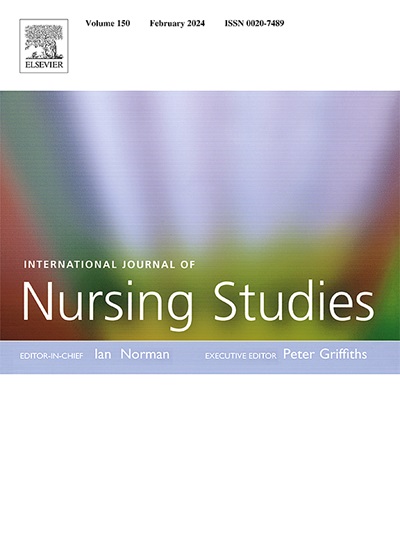Effectiveness of non-instrumental early mobilization to reduce the incidence of deep vein thrombosis in hospitalized patients: A systematic review and meta-analysis
IF 7.5
1区 医学
Q1 NURSING
引用次数: 0
Abstract
Background
Deep vein thrombosis (DVT) poses a significant health risk, particularly in hospitalized patients with multiple risk factors (cigarette smoking, hypertension, diabetes and obesity). Despite advances in treatment, DVT remains a prevalent complication of hospitalization.
Objective
To assess the effectiveness of non-instrumental mobilization in hospitalized patients at high risk of DVT, exploring the challenges and variations in intervention protocols.
Design
Systematic review and meta-analysis.
Setting(s)
Not applicable.
Participants
Hospitalized patients at risk of deep vein thrombosis.
Methods
A systematic search of three databases was conducted from interception to September 2023 for randomized controlled trials. This study was registered in PROSPERO (CRD42023460485). This study was conducted according to PRISMA 2020 statement. Two authors independently screened the studies and extracted the data. The quality of the studies was evaluated using the Downs and Black checklist and GRADE system. The amount of evidence certainty was assessed using the Cochrane Risk of Bias Assessment tool. Meta-analysis was performed addressing the incidence of deep vein thrombosis during hospitalization.
Results
7 studies were eligible for inclusion which included a total of 1774 participants. Interventions ranged from active and passive ankle exercises to walking. Meta-analysis demonstrated a significant overall effect in favor of non-instrumental early mobilization compared to usual care (RR = 0.55; 95 % CI = 0.41, 0.73; p < 0.0001). Subgroup analysis comparing type of mobilization revealed significant effects for global (RR = 0.54; 95 % CI = 0.38, 0.78; p = 0.001) and remote mobilization (RR = 0.25; 95 % CI = 0.07, 0.86; p = 0.03).
Conclusions
Non-instrumental early mobilization is beneficial in reducing the incidence of deep vein thrombosis in hospitalized patients.
Registration
PROSPERO, registration number: CRD42023460485.
非器械性早期动员对降低住院患者深静脉血栓发生率的效果:系统回顾和荟萃分析
背景深静脉血栓形成(DVT)对健康构成重大风险,尤其是对具有多种风险因素(吸烟、高血压、糖尿病和肥胖)的住院患者。目的 评估非器械动员对深静脉血栓高危住院患者的有效性,探讨干预方案中存在的挑战和差异。方法 从截取到 2023 年 9 月,对三个数据库中的随机对照试验进行了系统检索。本研究已在 PROSPERO(CRD42023460485)中注册。本研究根据 PRISMA 2020 声明进行。两位作者独立筛选研究并提取数据。研究质量采用 Downs and Black 检查表和 GRADE 系统进行评估。使用 Cochrane 偏倚风险评估工具评估了证据的确定性。针对住院期间深静脉血栓形成的发生率进行了 Meta 分析。结果有 7 项研究符合纳入条件,共纳入 1774 名参与者。干预措施包括主动和被动踝关节锻炼以及步行。Meta 分析表明,与常规护理相比,非器械性早期动员的总体效果显著(RR = 0.55; 95 % CI = 0.41, 0.73; p < 0.0001)。比较动员类型的分组分析显示,整体动员(RR = 0.54; 95 % CI = 0.38, 0.78; p = 0.001)和远程动员(RR = 0.25; 95 % CI = 0.07, 0.86; p = 0.03)具有显著效果:CRD42023460485。
本文章由计算机程序翻译,如有差异,请以英文原文为准。
求助全文
约1分钟内获得全文
求助全文
来源期刊
CiteScore
15.00
自引率
2.50%
发文量
181
审稿时长
21 days
期刊介绍:
The International Journal of Nursing Studies (IJNS) is a highly respected journal that has been publishing original peer-reviewed articles since 1963. It provides a forum for original research and scholarship about health care delivery, organisation, management, workforce, policy, and research methods relevant to nursing, midwifery, and other health related professions. The journal aims to support evidence informed policy and practice by publishing research, systematic and other scholarly reviews, critical discussion, and commentary of the highest standard. The IJNS is indexed in major databases including PubMed, Medline, Thomson Reuters - Science Citation Index, Scopus, Thomson Reuters - Social Science Citation Index, CINAHL, and the BNI (British Nursing Index).

 求助内容:
求助内容: 应助结果提醒方式:
应助结果提醒方式:


